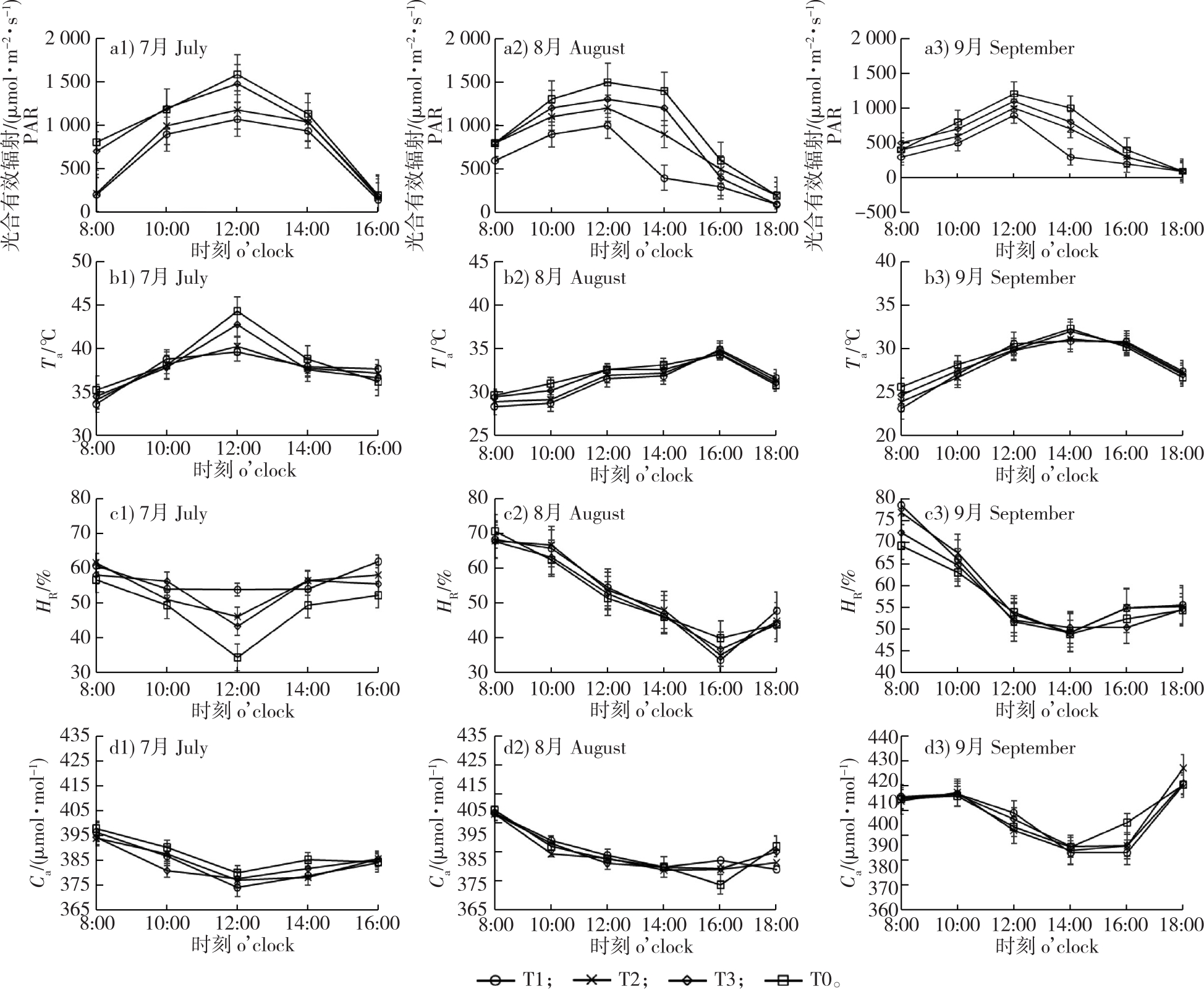 PDF(3031 KB)
PDF(3031 KB)


The effects of intercropping of Carya illinoinensis and Camellia sinensis ‘Anjibaicha’ on photosynthetic characteristics of C. sinensis tree during rapid growth period
TIAN Mengyang, ZHU Shulin, DOU Quanqin, JI Yanhong
Journal of Nanjing Forestry University (Natural Sciences Edition) ›› 2024, Vol. 48 ›› Issue (2) : 86-96.
 PDF(3031 KB)
PDF(3031 KB)
 PDF(3031 KB)
PDF(3031 KB)
The effects of intercropping of Carya illinoinensis and Camellia sinensis ‘Anjibaicha’ on photosynthetic characteristics of C. sinensis tree during rapid growth period
【Objective】 This article explores the differences in photosynthetic and fluorescence characteristics of Camellia sinensis ‘Anjibaicha’ at different measuring points of Carya illinoinensis-Camellia sinensis intercropping to provide a theoretical basis for high-efficiency compound cultivation of Carya illinoinensis-Camellia sinensis ‘Anjibaicha’.【Method】 In this compound model, the daily change in photosynthetic rate, light-response curves, fluorescence parameters and chlorophyll content of 10-year-old Camellia sinensis ‘Anjibaicha’ trees were measured in the fast-growing period (July-September) at four measuring points, i.e., under-crown (T1), crown-margin (T2), outside-crown (T3), and single Camellia sinensis comparison (T0).【Result】 The net photosynthetic rate(Pn) of Camellia sinensis ‘Anjibaicha’ could be significantly altered in T2. The Pn values at T1, T2 and T3 were significantly higher than those at T0 in July under high temperatures. The leaves had a midday depression of photosynthesis at T0 in August, and the Pn at T2 was significantly higher than that at T0. The Pn at different measuring points (T1, T2 and T3) were significantly higher than those of T0 in September. Compared with the control (T0), the higher apparent quantum efficiency (ηAQY), maximum net photosynthetic rate ( ), and light saturation point (PLSP) were high, and the light compensation point (PLCP) was low at T2. The dark respiration rate (Rd) gradually decreased with decreasing light intensity. From July to September, the chlorophyll content of Camellia sinensis leaves was significantly higher in intercropping than in single Camellia sinensis cropping. With the decrease in light intensity, chlorophyll a (Chla), chlorophyll b (Chlb), and total chlorophyll (Chl) gradually increased, and the chlorophyll a/b value showed a decreasing trend. Camellia sinensis leaves produce more chlorophyll, which helps Camellia sinensis trees capture more light energy for photosynthesis. The maximum photochemical efficiency (FV/Fm) and potential photochemical activity (FV/F0) of PSⅡ of Camellia sinensis trees in intercropping were significantly higher than those of single Camellia sinensis cropping in July and August. The light energy conversion efficiency and electron transfer ability of Camellia sinensis ‘Anjibaicha’ leaves in single cropping decreased because high temperature and high-intensity light could produce obvious photoinhibition. In September, the FV/Fm and FV/F0 of Camellia sinensis trees at T2 during intercropping were significantly higher than those of T1 and T0. The results showed that excessive shading inhibited the photochemical activity of PSⅡ, which blocked energy transfer and transformation in photosynthesis. 【Conclusion】 In the Carya illinoinensis-Camellia sinensis ‘Anjibaicha’ forest compound model, many photosynthetic physiological indexes of Camellia sinensis ‘Anjibaicha’ were improved, among which the crown-margin (T2) environment was favorable for the photosynthesis of Camellia sinensis ‘Anjibaicha’ leaves, followed by the outside-crown (T3), and the under-crown (T1) and monoculture (T0) were poor. High temperature and high-intensity light have obvious photoinhibition in single-cropped Camellia sinensis ‘Anjibaicha’, which reduced photosynthetic efficiency.

Carya illinoinensis / Camellia sinensis ‘Anjibaicha’ / intercropping / photosynthetic characteristic parameters / chlorophyll fluorescence
| [1] |
尧渝, 张厅, 马伟伟, 等. 不同间作模式对茶树光合生理及茶叶品质的影响[J]. 山西农业科学, 2016, 44(4):470-473.
|
| [2] |
巩雪峰, 余有本, 肖斌, 等. 不同栽培模式对茶园生态环境及茶叶品质的影响[J]. 西北植物学报, 2008, 28(12):2485-2491.
|
| [3] |
阮旭, 张玥, 杨忠星, 等. 果茶间作模式下茶树光合特征参数的日变化[J]. 南京农业大学学报, 2011, 34(5):53-57.
|
| [4] |
周志翔. 林茶间作下的光照条件与茶树生理生态研究综述[J]. 生态学杂志, 1995, 14(3):56-63.
|
| [5] |
谢文钢, 邵济波, 韩楠, 等. 安吉白茶的研究进展及发展前景[J]. 蚕桑茶叶通讯, 2011(5):22-25.
|
| [6] |
邓静, 王远兴, 丁建. 白茶与安吉白茶的研究进展[J]. 食品工业科技, 2013, 34(4):368-371,377.
|
| [7] |
方敏瑜, 傅懋毅, 李纪元, 等. 林-茶间种模式对安吉白茶生长的防护功能分析[J]. 林业科学研究, 1999, 12(4):433-437.
|
| [8] |
唐荣南, 汤兴陆. 湿地松与茶树间作生态效应的研究[J]. 南京林业大学学报(自然科学版), 1987, 11(2):35-44.
|
| [9] |
叶子飘. 光合作用对光和CO2响应模型的研究进展[J]. 植物生态学报, 2010, 34(6):727-740.
|
| [10] |
潘平平, 窦全琴, 谢寅峰, 等. 薄壳山核桃15个家系子代苗期生长和荧光特性比较[J]. 江西农业大学学报, 2019, 41(3):454-463.
|
| [11] |
汤文华, 窦全琴, 潘平平, 等. 不同薄壳山核桃品种光合特性研究[J]. 南京林业大学学报(自然科学版), 2020, 44(3):81-88.
|
| [12] |
孙君, 朱留刚, 林志坤, 等. 茶树光合作用研究进展[J]. 福建农业学报, 2015, 30(12):1231-1237.
|
| [13] |
陆文渊, 钱文春, 赖建红, 等. 安吉白茶品质的气候成因初探[J]. 茶叶科学技术, 2012, 53(3):37-39.
|
| [14] |
季琳琳, 佘诚棋, 肖正东, 等. 油茶-茶复合模式对茶树光合特性的影响[J]. 经济林研究, 2013, 31(1):39-43.
|
| [15] |
江新凤, 李琛, 蔡翔, 等. 遮阴对 “黄金菊” 茶树生长与茶叶品质的影响[J]. 茶叶通讯, 2019, 46(4):424-428.
|
| [16] |
李杰, 贾豪语, 颉建明, 等. 生物肥部分替代化肥对花椰菜产量、品质、光合特性及肥料利用率的影响[J]. 草业学报, 2015, 24(1):47-55.
|
| [17] |
叶子飘, 谢志亮, 段世华, 等. 设施栽培条件下三叶青叶片光合的气孔和非气孔限制[J]. 植物生理学报, 2020, 56(1):41-48.
|
| [18] |
|
| [19] |
赵康, 肖正东, 佘诚棋, 等. 栽培模式对茶树叶片光合生理及茶叶品质的影响[J]. 安徽农业大学学报, 2012, 39(6):934-939.
|
| [20] |
张勇, 程怡, 王清明, 等. 遮荫对月季光合特性及生长发育的影响[J]. 西北植物学报, 2014, 34(1):162-168.
|
| [21] |
|
| [22] |
|
| [23] |
闫小莉, 王德炉. 遮荫对苦丁茶树叶片特征及光合特性的影响[J]. 生态学报, 2014, 34(13):3538-3547.
|
| [24] |
王晨光, 郝兴宇, 李红英, 等. CO2浓度升高对大豆光合作用和叶绿素荧光的影响[J]. 核农学报, 2015, 29(8):1583-1588.
|
| [25] |
原向阳, 郭平毅, 黄洁, 等. 缺磷胁迫下草甘膦对抗草甘膦大豆幼苗光合作用和叶绿素荧光参数的影响[J]. 植物营养与肥料学报, 2014, 20(1):221-228.
|
| [26] |
许大全. 光合作用学[M]. 北京: 科学出版社: 2013,94-95, 231-232.
|
| [27] |
潘伟彬. 生态茶园复合栽培的农学与生态学研究[J]. 江西农业学报, 2009, 21(2):65-67,70.
|
| [28] |
杨巨仙, 窦全琴. 薄壳山核桃等3树种叶片水浸液对茶树种子萌发和幼苗生长的影响[J]. 江苏林业科技, 2022, 49(3):1-8.
|
/
| 〈 |
|
〉 |